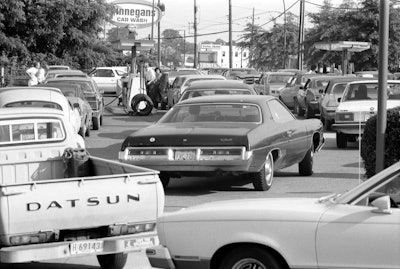
President Biden admitted something of a defeat on Wednesday, losing any semblance of optimism in fighting runaway fuel prices and other inflation.
“There’s a lot going on right now," he told reporters, "but the idea we’re going to be able to, you know, click a switch, bring down the cost of gasoline, is not likely in the near term, nor is it with regard to food. ... We can’t take immediate action that I’m aware of yet to figure out how we’re going to bring down the price." Diesel, too, of course.
Days earlier, Fatih Birol, the head of the International Energy Agency, warned that this summer's fuel issues could dwarf even the historic 1973 oil crisis, when prices doubled as Middle Eastern nations in OPEC's predecessor put an oil embargo on the U.S. as punishment for support of Israel during the Yom Kippur War. It all sparked turmoil here -- high prices, fuel rationing, legislative moves toward an eventual 55 mph national speed limit, and plenty of protest among trucking factions.
[Related: Fuel-market insanity: A tale of two loads, bedrock cost-control/rates-management tactics]
“When the main holiday season starts in Europe and the US, fuel demand will rise,” Birol told German publication Der Spiegel, according to translations. “Then we could see shortages -- for example, in diesel, petrol or kerosene, particularly in Europe.”

When it comes fuel impacts, what happens in Europe, clearly, isn't staying in Europe, as the war in Ukraine has shown in the form of quick fuel-price inflation. Complicating matters, the 70s crisis was "just about oil,” Birol said. “Now we have an oil crisis, a [natural] gas crisis and an electricity crisis simultaneously.”
The biggest issue going for most owner-operators in the U.S. isn't with fuel's supply, though. It's cost, with the pain spread far and wide but particularly pronounced out West and now in the Northeast. As reported yesterday, New York Governor Kathy Hochul this week suspended certain state taxes on fuels, which should amount to about 15 cents per gallon for diesel, not much given how high diesel is there.
With no end in sight, pundits have predicted a "trucking bloodbath" that would put thousands of trucking companies out of business. But according to at least two owner-operators, the getting is still good, if you know what you're doing.
J.R. Quirion regular readers may recall from his Western Star's inspection in Vermont during Roadcheck. Quirion said he makes his best profit when fuel prices go high.
[Related: Who is to blame for record high diesel prices?]
 Owner operator J.R. Quirion gets inspected at Roadcheck in White River Junction, Vermont.Alex Lockie for Overdrive
Owner operator J.R. Quirion gets inspected at Roadcheck in White River Junction, Vermont.Alex Lockie for Overdrive
Quirion sees less-efficient operators sidelined by high fuel prices, leading higher demand for his services. He uses an EFS fuel card to save 10 or 20 cents off the pump price for diesel, and says he runs his 1999 Western Star a bit slower to boost fuel mileage.
While Quirion, who mostly hauls in the Northeast and back to his native Canada, did appreciate the New York State tax break on fuel, he said it mostly doesn't matter -- it all comes out in the wash with quarterly IFTA reports.
"A couple years back we used to try to prioritize getting fuel in Virginia or New Jersey or Delaware, where it's sometimes cheaper," he said, but now he says he doesn't see much variation in price from station to station. While states with low fuel taxes might feel good when swiping your card, "when your three months is due," the high-tax states you've run through are still going to get their money.
[Related: In-depth refresher on IFTA accounting]
Overall, Quirion sounded confident in the knowledge that his work hauling steel and lumber can't be replaced, and any economy that works will find a way to pay him for his time and effort.
He hauls mostly "for Canam Steel. They're honest with us," he said. "They pay us what we need to get by and pay the fuel and keep up with equipment. But really, they're looking after themselves when they're looking after us. We do a good job for them. They do a good job for customers. Companies have to pay us well" or the consequence is poor service.
Connecticut-based regional steel hauler Joe Bielucki tended to agree with Quirion. Every year for the past several, Bielucki has put in bids for his desired shipping lanes from his main customer. Last year, sensing a shift as the new administration came in, he hiked his rates and won just five or six out of 35 bids placed.
"A year is a long time," Bielucki reasoned. Within that annual contract, however, are weekly updated fuel surcharges pulling data from the government's averages.
 Connecticut-based open-deck owner-op Joe Bielucki, with his Cummins X15-powered 2020 Peterbilt 567
Connecticut-based open-deck owner-op Joe Bielucki, with his Cummins X15-powered 2020 Peterbilt 567
He's seen rates balloon on short hauls in his area, but knows that often drivers with big carriers won't see that money -- all of it, anyway.
"Some of the rates on short-haul we've seen increase 100% or more on the linehaul," he said. "A local run that was $500 now may be $1,000, but I've been in business long enough to know" another carrier hauling that is probably going to give a leased owner "maybe $650 to do the trip."
Bielucki considers himself lucky to be a position where he can "hold the line" and refuse to work for cheap, but he cautions that many in the industry can't see or make that decision.
"I always tell the young owner ops, if you try to just run more loads but you’re behind what your cost is, you’re never going to get caught up," he said. "You can't do a couple bad loads in hopes to sooner or later get a good load. A couple bad loads in, now you’re behind the eight ball. Say you're at six miles per gallon and diesel is $6, that's about a dollar a mile. If you deadhead out 150 miles, it will cost you $150 just to run out there, nevermind the wear and tear on the truck.
"Know your damn cost per mile," Bielucki concludes. "Running 100 miles down the road isn't going to work if you're just going to be stranded somewhere without a backhaul."
Bielucki doesn't care much for politics or one party or another, but for now he agrees with the Biden administration's assessment that prices won't come down anytime soon. He predicts a recession might help "shake out the dead wood" from the industry, but believes "the strong people always survive."
[Related: Keeping cool, in control, as difficulties heat up: Was truck ownership supposed to be this hard?










